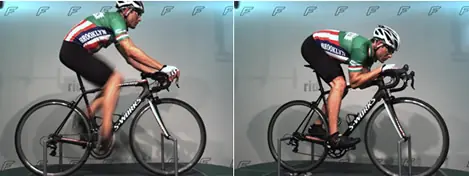Sitting at my FASTER desk, the view changes considerably from day to day. My "view" is the main window into the wind tunnel. Some days it is filled with sleek time trial bikes, other days road bikes, and platform arms will be configured for track bikes soon. The best days are those with athletes slicing off the final few grams of aerodynamic drag from bike jersey and bibs. The mantra there is that human skin appears to be VERY aerodynamic.
We all have the mental image of a professional time trial event with a rider frozen into the classic aero position with back flat, head very low, and with arms tucked and elongated to a centered-stretched position. That position is held through corners and up hills as much as possible.
Cycling Events Near You
For road racing and criteriums, the body position on the bike is dramatically more dynamic. We adjust for comfort riding in everyday riding, as well as in corners and hills, in both our upper and lower body position. These adjustments can be aero cheaters or aero drag chutes depending upon intent and execution of a few critical elements.
More: 5 Things I Learned in the Wind Tunnel
Hydrating
Think about grabbing that drink bottle for a quick gulp of your favorite hydration. Bottle cages behind the seat require opening up and twisting the torso adding significant drag and associated deceleration while taking quite a long bit of time to execute the get-and-replace movements.
Bottles cages on the down tube allow a lower torso position when reaching for the bottle and considerably shorter time to execute. Keep your head and bottle low for a quick fueling.
Volume is everything as drinking early and fewer times disturbs your air flow less for any particular ride than numerous short drinks. Aero drag is proportional to your frontal area and velocity [squared], so take hydration on low speed sections of your ride and in corners when the air flow is disrupted by directional changes, keeping stability in mind for road safety.
More: Time in the Wind Tunnel Pays Off Later
Downhill Position
We had our own FASTER master mechanic Mark Bunz in the wind tunnel to illustrate the effects of dynamic body positioning in classic rider positions.

Note that in the aero position Mark's legs, arms and torso maintain body flexibility to absorb road irregularities, and front-to-back balance is optimized too, allowing him to maintain the position for sustained periods of time. Riding with his butt on the top tube and hands off the handlebars may seem faster, but it significantly impairs bike handling dynamics. (See a video of Mark's wind tunnel test).
Mark's aero tuck is an astounding 1,078 grams less drag at wind angles averaged over zero to 30 degrees. That translates to a very significant 10 seconds per kilometer faster! Many downhill sections of our rides are a half mile or longer and putting 10, 20 or 30 seconds on the competition, so to speak, is significant.
Keep mindful of your bike handling skills and work on that super slippery downhill position.
More: Improve Your Aero Positioning With These 5 Stretches
 Ready to ride? Search for a cycling event.
Ready to ride? Search for a cycling event.

